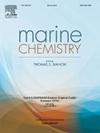巴伦支海北部冬季至春季过渡期间溶解有机质化学成分的变化
IF 2.5
3区 地球科学
Q2 CHEMISTRY, MULTIDISCIPLINARY
引用次数: 0
摘要
北冰洋溶解有机物(DOM)的分子特征研究很少,特别是在冬季,这是水团混合和碳循环的关键时期。延伸到北冰洋的北巴伦支海正以比全球平均速度快5-7倍的速度经历着全球变暖,导致了剧烈的化学、物理和生态系统变化。我们在冬初(12月)、冬末(3月)和春季(5月)对该地区的样带进行采样,并使用高分辨率质谱分析海水样本。结果表明,生物季节性和水循环(横向和垂直水运)对DOM组成的影响显著,而水团对DOM组成的影响不显著。通过加权平均氢碳原子比(H/Cwa) (- 0.029, Mann-Whitney U检验,p <;0.001)。冬末DOM的高不稳定性与高含氮配方有关,这可能是病毒过程产生的DOM产物的结果。北极盆地和巴伦支海大陆架断裂的深水在春季表现出更大的不稳定性,这表明来自生物活跃的大陆架区域的水循环的影响。初冬时,CHO分子式的加权平均芳香性指数(AImod)、双键当量(DBE)和相对强度均高于含杂原子(N, S)的分子式,支持DOM的存在,且具有较高的顽固性。初冬陆源峰(t-Peaks)的数量也显著增加(p <;0.001),表明这些河流标记物是季节性去除的。在冬季海水混合时,DOC可能被输送到更深的海洋层。我们的发现弥补了冬季DOM分子表征方面的空白,为未来评估北极DOM反应性的潜在变化提供了可能。本文章由计算机程序翻译,如有差异,请以英文原文为准。
Variation in chemical composition of dissolved organic matter during the winter to spring transition in the northern Barents Sea
Molecular characterization of dissolved organic matter (DOM) from the Arctic Ocean is scarce, especially during the winter, which is a crucial period for water mass mixing and carbon cycling. The northern Barents Sea extending into the Arctic Ocean is experiencing global warming at a rate 5–7 times faster than the global average, leading to drastic chemical, physical and ecosystem changes. We sampled a transect along this region during early winter (December), late winter (March) and spring (May) and analyzed seawater samples using high-resolution mass spectrometry. Our results show significant changes in DOM composition driven by biological seasonality and water circulation such as lateral and vertical water transport, whereas water masses did not exhibit significant correlations with DOM composition. Our mass spectrometry-based results indicate that ionizable DOM compounds in early winter contained a greater proportion of unsaturated compounds relative to late winter and spring, as shown by weighted average hydrogen to carbon atomic ratios (H/Cwa) (−0.029, Mann-Whitney U test, p < 0.001). Higher DOM lability in late winter was associated with higher nitrogen containing formulas which could be a result of DOM products from viral processes. Deep waters in the Arctic Basin and on the Barents Sea shelf break show greater lability in spring suggesting an influence of water circulation from the biologically active shelf regions. In early winter, higher weighted average aromaticity index (AImod), double-bond equivalents (DBE) and relative intensities of CHO formulas over heteroatom (N, S)-containing formulas were observed, thus supporting the presence of DOM with higher recalcitrance. Early winter also exhibited a significantly higher number of terrigenous peaks (t-Peaks) (p < 0.001), suggesting seasonal removal of these riverine markers. This DOC may be transported to deeper ocean layers during winter water mixing. Our findings bridge the gap in winter DOM molecular characterization, which allows for future assessments of potential changes in the Arctic DOM reactivity.
求助全文
通过发布文献求助,成功后即可免费获取论文全文。
去求助
来源期刊

Marine Chemistry
化学-海洋学
CiteScore
6.00
自引率
3.30%
发文量
70
审稿时长
4.5 months
期刊介绍:
Marine Chemistry is an international medium for the publication of original studies and occasional reviews in the field of chemistry in the marine environment, with emphasis on the dynamic approach. The journal endeavours to cover all aspects, from chemical processes to theoretical and experimental work, and, by providing a central channel of communication, to speed the flow of information in this relatively new and rapidly expanding discipline.
 求助内容:
求助内容: 应助结果提醒方式:
应助结果提醒方式:


